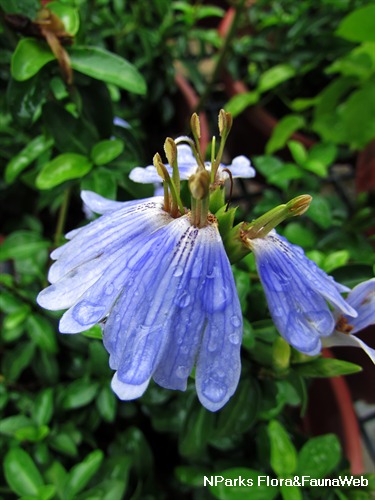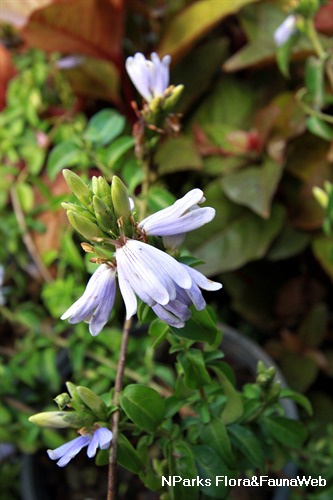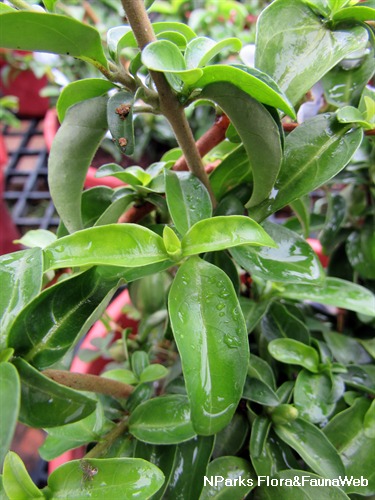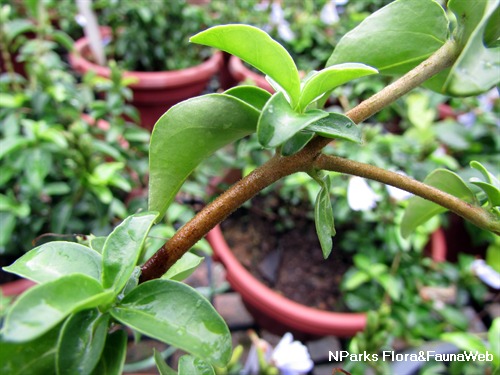
Name
Classifications and Characteristics
| Plant Division | Angiosperms (Flowering Seed Plants) (Dicotyledon) |
|---|---|
| Plant Growth Form | Shrub |
| Lifespan (in Singapore) | Perennial |
| Mode of Nutrition | Autotrophic |
| Plant Shape | Rounded |
Biogeography
| Native Distribution | Zimbabwe |
|---|---|
| Native Habitat | Terrestrial (Primary Rainforest) |
| Preferred Climate Zone | Tropical, Sub-Tropical / Monsoonal |
Description and Ethnobotany
| Growth Form | It is a multi-stemmed rounded shrub can usually grow up to 3 m high. Branches are soft wood and thin, occasionally scramble into neighbouring vegetation. |
|---|---|
| Foliage | Leaves are small,oval to elliptic, glossy deep-green above and dull-green on the undersides. Leaf margins are entire to irregularly toothed. |
| Flowers | Flowers are solitary, borne on stem tips. They are mauve-blue to purple, lower petals are ribbed, that gives the impression of lips, hence the common name Blue Lips. The flower has five fringed lobes which are equal in size, and rounded. |
| Fruit | Green capsule with tapering tip. Mature fruit splits open into two halves, releasing seeds. |
| Habitat | Found on margins of evergreen forests, at an altitude of 90 - 1700 m. |
| Cultivation | Best grown in a semi-shaded area on well-drained soils. The soil is best rich in nutrients, to mimic the thick layer of leaf mulch found in forest floor. Propagate via seeds or stem cuttings. Application of rooting hormone on stem cuttings helps to increase success of rooting. Plant can be lightly pruned and trained into small formal hedge or used as topiary. |
| Etymology | The genus Sclerochiton is from Greek, meaning hard covering, refering to the woody cover of fruit capsule. The specific epithet harveyanus is named after William Henry Harvey, an Irish systematic botanist, Colonial Secretary in S. African Cape and curator at Trinity College Dublin. |
Landscaping Features
| Landscaping | The blue flowers create beautiful floral display together with glossy green foliage. |
|---|---|
| Desirable Plant Features | Ornamental Flowers |
| Landscape Uses | Parks & Gardens, Small Gardens, Flowerbed / Border, Container Planting |
Fauna, Pollination and Dispersal
| Pollination Method(s) | Biotic (Fauna) |
|---|---|
| Seed or Spore Dispersal | Abiotic |
Plant Care and Propagation
| Light Preference | Semi-Shade |
|---|---|
| Water Preference | Moderate Water |
| Plant Growth Rate | Fast |
| Rootzone Tolerance | Well-Drained Soils, Fertile Loamy Soils |
| Potential Problems | Mealy bug. |
| Propagation Method | Seed, Stem Cutting |
Foliar
| Foliage Retention | Evergreen |
|---|---|
| Mature Foliage Colour(s) | Green |
| Mature Foliage Texture(s) | Glossy / Shiny |
| Prominent Young Flush Colour(s) | Green |
| Young Flush Texture(s) | Glossy / Shiny |
| Foliar Type | Simple / Unifoliate |
| Foliar Arrangement Along Stem | Opposite |
| Foliar Attachment to Stem | Petiolate |
| Foliar Shape(s) | Non-Palm Foliage (Oval, Elliptical) |
| Foliar Venation | Pinnate / Net |
| Foliar Margin | Entire - Wavy / Undulate, Serrate / Toothed |
Floral (Angiosperm)
| Flower & Plant Sexuality | Bisexual Flowers |
| Flower Colour(s) | Blue |
|---|---|
| Flower Grouping | Solitary |
| Flower Location | Axillary, Terminal |
| Flower Symmetry | Bilateral |
| Flowering Period | Free-Flowering |
Image Repository
Others
| Master ID | 32520 |
|---|---|
| Species ID | 6932 |
| Flora Disclaimer | The information in this website has been compiled from reliable sources, such as reference works on medicinal plants. It is not a substitute for medical advice or treatment and NParks does not purport to provide any medical advice. Readers should always consult his/her physician before using or consuming a plant for medicinal purposes. |



